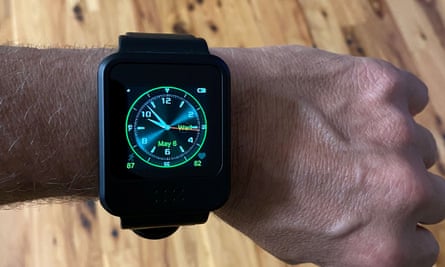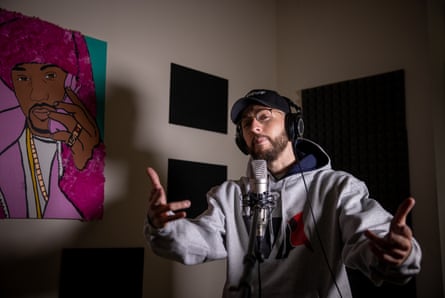In 2018, William Frederick Keck III pleaded guilty in a court in Manassas, Virginia, to possession with intent to distribute cannabis. He served three months in prison, then began a three-year probation. He was required to wear a GPS ankle monitor before his trial and then to report for random drug tests after his release. Eventually, the state reduced his level of monitoring to scheduled meetings with his parole officer. Finally, after continued good behaviour, Keck’s parole officer moved him to Virginia’s lowest level of monitoring: an app on his smartphone.
Once a month, Keck would open up the Shadowtrack app and speak his answers to a series of questions so that a voice-recognition algorithm could confirm it was really him. He would then type out answers to several more questions – such as whether he had taken drugs – and the app would send his responses and location to his parole officer. Unless there was a problem, Keck would not have to interact with a human and the process could be completed during a TV ad break.
But for Keck, being put on to the app didn’t feel like a less intrusive reward for good behaviour. When downloading Shadowtrack, users must consent to having their location monitored in the background on their phone so parole officers can send “silent” location requests at any time. “It was cool to not have to report to a probation officer, it was cool to not have to take drug tests any more,” Keck says. “But that peace of mind, of not having somebody track your every move … it was like being locked up again.”
Keck is a rapper who goes under the stage name OG Illa. When he was placed on Shadowtrack, his career was starting to take off after the success of his single Kareem, he says. He had offers to tour and potential business meetings out of his state, all of which he had to turn down. Under the terms of his probation, he could not leave Virginia without going through a lengthy application process. And as using Shadowtrack – essentially a fancy chatbot with GPS – was the only interaction he had with the probation system, being at the lowest level of monitoring seemed less conducive to rehabilitation than physical meetings with his probation officer.
Virginia has used Shadowtrack since autumn 2015 and about 11,000 Virginians are monitored by the app, says Dale Jacobson, who runs the Virginia Department of Corrections’ voice-verification biometrics unit.
“It’s saving countless hours on the officer’s part,” Jacobson says. He believes, from anecdotal evidence, that slightly fewer low-risk probationers are getting arrested since Virginia began using Shadowtrack instead of calling landlines at probationers’ curfew locations. As the pandemic wore on, the department started using the app’s video-conference function to conduct safe meetings with probationers deemed at higher risk of reoffending. “I can’t imagine it going away,” Jacobson says.

Shadowtrack is one of an array of apps that, boosted by the Covid-19 pandemic, are increasingly being used in state criminal justice systems and federal immigration courts to track people while they await trial or are on probation or parole. They are easier to install than GPS ankle bracelets, come with a tantalising variety of analytics features, and are much cheaper. In some jurisdictions, the person being monitored must pay a daily fee instead of the justice agency purchasing the service.
Ease of use is one of the aspects that most worries civil liberties groups and prison reformers about probation tracking apps. The companies marketing the apps – including BI Incorporated, Outreach Smartphone Monitoring, TrackTech, Telmate and others – say the tools will lead to lower incarceration rates and replace stigmatising and often physically painful ankle bracelets.
“We’ve built so many features into our technology to minimise technical violations,” says Robert Magaletta, chief executive of Shadowtrack. “We would love to get people off the programme as a successful participant and move on.”
In Virginia, Shadowtrack is not replacing ankle bracelets, it is just a new kind of monitoring. And at the federal level, where US Immigration and Customs Enforcement (ICE) uses the SmartLink app created by BI Inc, the little data available suggests both methods are growing. In the 2020 tax year, ICE monitored 28,581 people through bracelets and 23,804 through SmartLink, according to detention data published by the agency. So far in 2021, there are 29,459 people using bracelets and 26,597 using SmartLink. “It is not a substitute for detention, but allows ICE to exercise increased supervision over a portion of those who are not detained” based on factors such as their immigration history, community ties and medical condition, the agency said.

“There hasn’t been a replacement of one for the other, it’s just been a pretty constant expansion of both,” says Jacinta González, an organiser with the immigrant advocacy group Mijente. Critics also argue that the data-gathering and experimental predictive analytics incorporated into some tracking apps are bound to generate false positives that lead to arrests for technical violations of probation or parole conditions. “The predictive stuff is really, really crazy,” González says. “This is where we have to be thinking about worst-case scenarios.”
SmartLink, for example, interfaces with BI’s TotalAccess software, which, according to the company’s product brochure, uses predictive analytics to calculate a person’s likelihood of absconding and what their travel patterns say about their access to “risk locations”. BI is a subsidiary of the private prison company GEO Group.
Shadowtrack, meanwhile, boasts that its voice-recognition algorithms can also detect whether a person has been using alcohol or drugs. “We have some proprietary software built in that can detect some slurs in speech, and so forth, that would just maybe warrant a follow-up,” says Magaletta.
The next generation of monitoring technology promises to go even further. Researchers at Purdue University in Indiana, funded by a federal grant, are combining tracking apps with devices that monitor the user’s cortisol levels and heart rate as markers for stress. That biometric data, along with location histories and other information collected through apps, will be fed into algorithms to determine whether a person is engaging in risky behaviour that could lead to reoffending, potentially sending an automatic alert to a parole officer.
Q&AWhat is the Digital Citizens series?
Show
As part of our Rights and Freedoms project, we investigate how rapid advances in data-intensive technologies are affecting human rights around the world.
Under the cover of the pandemic, many governments have used digital technologies to track and analyse citizens' movements, quash dissent and curtail free speech – while on digital platforms truth has been manipulated and misinformation spread.
But technology can also be a powerful force for hope and justice, helping to preserve rights and freedoms in the face of rising authoritarianism.
In some jurisdictions, the pandemic is leading to the rapid adoption of these apps for broad populations of offenders.
For several months in 2020, the pandemic prompted Illinois to cancel in-person meetings and forced parolees to install SmartLink. Michael, who was paroled in 2019 after serving 23 and a half years of a sentence for murder, says that when the Illinois Department of Corrections eventually restarted face-to-face visits last autumn, his parole officer told him he could not uninstall the app. Michael, who prefers to use his first name only to protect his employment prospects, says SmartLink had been inconvenient and made him fear being rearrested for a technical violation.
He was returning home from work on the bus one day and did not notice that his parole officer had called him through SmartLink. Because parolees such as Michael can theoretically carry their phones with them wherever they go, failing to answer a call can count as a violation.
“To be subject, at any given time, for you to get a call and they’re like, ‘Where you at?’, and you have to stop doing what you’re doing – it’s very uncomfortable. You’ll be at work, you don’t want to answer the phone,” Michael says. “I was one of the lucky ones where I had an understanding PO [parole officer]. It’s sad to say, a lot of the POs are not understanding. A lot of them would prefer for us to rot in prison. Some don’t believe there’s such a thing as rehabilitation.”
According to Robert Murnock, vice-president for partnership development at BI, parole officers are going to use whatever tools are available to them, apps or otherwise, to contact those they are supervising. “We don’t promote that you can call them more or call them less, we say ‘here’s a tool to help manage them’,” he says.

In 2019, Illinois passed a law that, for the first time, requires its Department of Corrections to publish data about how many people are subjected to electronic monitoring, broken down by ethnicity and other factors. Another bill, which would have stripped probation officials of the power to place many parolees and probationers on electronic monitoring when it was not directly ordered by a court, was passed by Virginia’s lower house but stalled in the state senate.
The Illinois Department of Corrections has not responded to a request for comment, and it has not yet published the required data about electronic monitoring.
Prof Chaz Arnett, of Maryland University law school,sees the hype around probation tracking apps as a way of “tech-washing” conservative prison reform efforts with a trendy new artificial intelligence label and enriching the private incarceration industry.
“It doesn’t do anything to get at the fact that the criminal justice system itself is geared toward punishment, especially when you’re talking about underprivileged communities of colour,” says Arnett. “And once you get into these practices where you’re pulling data, biometric data, and these companies are using that data to further monetise their programmes and experiment, often it’s people of colour who are having their data extracted from them. This valuable commodity is literally the body of black individuals.”
